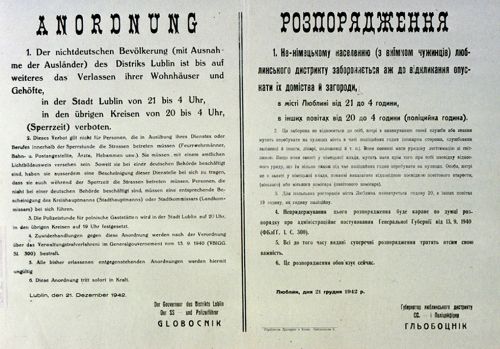Odilo Globocnik
The Head of Aktion Reinhardt

Globocnik (far right) on the ramp at Sobibor 1940 (Bundesarchiv)
Odilo Globocnik was born in Trieste on 21 April 1904. The son of an Austrian Croat family of petty officials and a builder by profession, he joined the Nazi Party in Carinthia, Austria in 1930 and became a ‘radical’ leader of its cells in the province. In 1933 Globocnik entered the SS and was appointed deputy district leader of the NSDAP in Austria. He was imprisoned for over a year on account of political offences, he re-

Globocnik - Second from left in Vienna (Chris Webb Private Archive)
He was dismissed from this position for illegal speculation in foreign exchange on 30 January 1939 and was replaced by Josef Burckel. Globocnik was pardoned by Himmler and appointed on 9 November 1939 as SS and Police Leader for the Lublin district in Poland. He was chosen by Himmler as the central figure in Aktion Reinhardt, the mass murder programme of Polish Jewry, no doubt because of his scandalous past record and well-

Proclamation by Globocnik (Bundesarchiv)
Globocnik built up a special company of SS men not subordinate to any higher authority and responsible only to Himmler, Globocnik established three death camps in Poland – Belzec, Sobibor and Treblinka as part of Aktion Reinhardt and had a hand in the creation of Lublin (Majdanek) concentration camp. Globocnik also built up an economic empire, including the Jewish labour camps at Budzyn, Krasnik, Poniatowa, Krasnik, Trawniki, as well as a number of camps in Lublin itself. Globocnik also was responsible for clearing Polish peasant farmers from the Zamość Lands and replacing them with ethnic Germans. Globocnik and some of his cohorts amassed rich rewards from the slaughter of approximately 1.6 million Jews whose property and valuables was seized by the SS, and his various business interests. As his situation reports showed, Globocnik carried out Himmler’s orders with brutal efficiency and by November 1943 Aktion Reinhardt had been completed and the three death camps under his control liquidated.

A New Year - Lublin 1941 Card from SS Brigadefuhrer Globocnik (Chris Webb Private Archive)
On 13 September 1943 Himmler wrote to Globocnik appointing him to the post of Higher SS and Police Leader for the Adriatic Coastal Zone in Trieste, and replacing him in Lublin by Jakob Sporrenberg. Himmler instructed Globocnik to produce a final accounting statement regarding the assets and economic achievements of Aktion Reinhardt by 31 December 1943. Globocnik provided a portfolio and on 5 January 1944 produced a detailed appendix. This appendix demonstrated that 178 million Reichmarks had been added to the Reich’s coffers as a result of Aktion Reinhardt. At the end of the war, Globocnik succeeded in evading arrest by returning to his native country in the mountains south of Klagenfurt. He was eventually tracked down and arrested by a British patrol at Wiessensee. He committed suicide by swallowing a cyanide capsule.See the article, 'The Death of Globocnik.' for the account of his suicide in 1945.
Sources:
Robert Wistrich, Who’s Who in Nazi Germany, Routledge, London 1995
J. Poprzeczny, Hitler’s Man in the East – Odilo Globocnik, McFarland, Jefferson 2004
Y. Arad, Belzec, Sobibor, Treblinka – The Aktion Reinhard Death Camps, Indiana University Press, Bloomington and Indianapolis 1987
National Archives Kew – FO 371/179969
Photographs and Documents – Bundesarchiv, and Chris Webb Private Archive
© Holocaust Historical Society November 9, 2019

